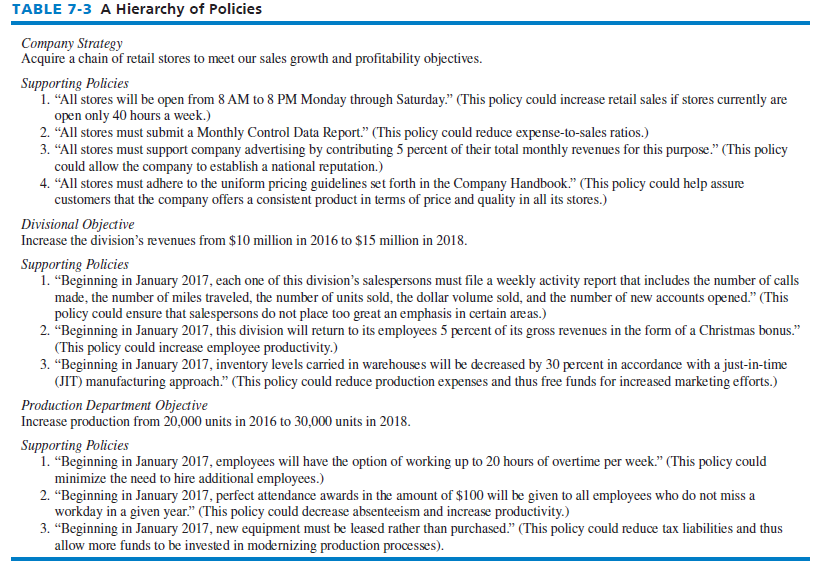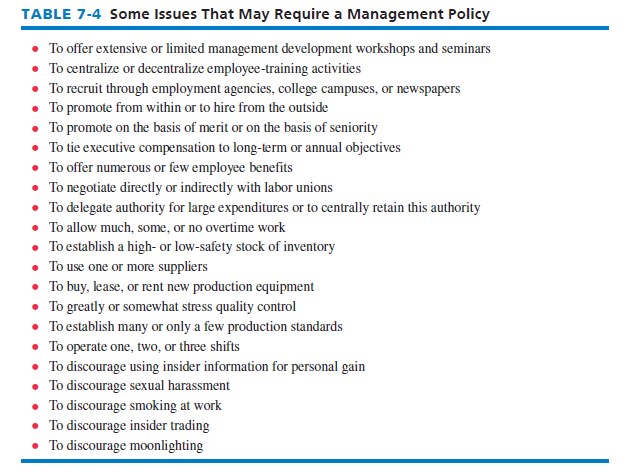Policies refer to specific guidelines, methods, procedures, rules, forms, and administrative practices established to support and encourage work toward stated goals. Changes in a firm’s strategic direction do not occur automatically. On a day-to-day basis, policies are needed to make a strategy work. Policies facilitate solving recurring problems and guide the implementation of strategy. Policies are essential instruments for strategy implementation, for at least six reasons:
- Policies set boundaries, constraints, and limits on the kinds of administrative actions that can be taken to reward and sanction behavior.
- Policies let both employees and managers know what is expected of them, thereby increasing the likelihood that strategies will be implemented successfully.
- Policies provide a basis for management control and allow coordination across organizational units.
- Policies reduce the amount of time managers spend making decisions. Policies also clarify what work is to be done and by whom.
- Policies promote delegation of decision making to appropriate managerial levels where various problems usually arise.
- Policies clarify what can and cannot be done in pursuit of an organization’s objectives.
As an example, some companies have a policy that bans employees from accessing their personal social media sites during work hours. Some companies are more stringent than others regarding social media policy. An excerpt from Gap, Inc.’s social media policy asserts, “Unless you are an authorized Social Media Manager for Gap, do not let social media affect your job performance.” Many organizations have a policy manual that serves to guide and direct behavior. Policies can apply to all divisions and departments (such as, “We are an equal opportunity employer”). Some policies apply to a single department (“Employees in this department must take at least one training and development course each year”). Whatever their scope and form, policies serve as a mechanism for implementing strategies and obtaining objectives. Policies should be stated in writing whenever possible. They represent the means for carrying out strategic decisions. Sometimes policies can be controversial, as described in the mini-case at the end of this chapter for Hilton Hotels.
Examples of policies that support a company strategy, a divisional objective, and a departmental objective are given in Table 7-3. Some example issues that may require a management policy are provided in Table 7-4.
Allocate Resources and Manage Conflict
1. Allocate Resources
All organizations have at least four types of resources (or assets) that can be used to achieve desired objectives: (1) financial resources, (2) physical resources, (3) human resources, and (4) technological resources. Resource allocation can be defined as distributing an organization’s “assets” across products, regions, and segments according to priorities established by annual objectives. Allocating resources is a vital strategy-implementation activity. Strategic management itself is sometimes referred to as a “resource allocation process.”
In organizations that do no strategic planning, resource allocation is often based on political or personal factors and bias, rather than being based on clear analysis and thought. Strategists should be wary of a number of factors that commonly prohibit effective resource allocation, including an overprotection of resources, too great an emphasis on short-run financial criteria, organizational politics, vague strategy targets, a reluctance to take risks, and a lack of sufficient knowledge. Below the corporate level, there often exists an absence of systematic thinking about resources allocated and strategies of the firm. Effective resource allocation does not guarantee successful strategy implementation because programs, personnel, controls, and commitment must breathe life into the resources provided. Yavitz and Newman explain why:
Managers normally have many more tasks than they can do. Managers must allocate time and resources among these tasks. Pressure builds up. Expenses are too high. The CEO wants a good financial report for the third quarter. Strategy formulation and implementation activities often get deferred. Today’s problems soak up available energies and resources. Scrambled accounts and budgets fail to reveal the shift in allocation away from strategic needs to currently squeaking wheels.


2. Manage Conflict
Honest differences of opinion, turf protection, and competition for limited resources can inevitably lead to conflict. Conflict can be defined as a disagreement between two or more parties on one or more issues. Establishing annual objectives can lead to conflict because individuals have different expectations, perceptions, schedules, pressures, obligations, and personalities. Misunderstandings between line managers (such as production supervisors) and staff managers (such as human resource specialists) can occur. For example, a collection manager’s objective of reducing bad debts by 50 percent in a given year may conflict with a divisional objective to increase sales by 20 percent. Conflict must be managed for strategy implementation to be successful. Managing conflict is a strategic issue in most, if not all, organizations.
Establishing objectives can lead to conflict because managers and strategists must make trade-offs, such as whether to emphasize short-term profits or long-term growth, profit margin or market share, market penetration or market development, growth or stability, high risk or low risk, and social responsiveness or profit maximization. Trade-offs are necessary because no firm has sufficient resources to pursue all strategies that would benefit the firm. Table 7-5 reveals some important management trade-off decisions required in strategy implementation. Strategic planning necessitates making effective trade-off decisions.
Conflict is not always bad. An absence of conflict can signal indifference and apathy. Conflict can serve to energize opposing groups into action and may help managers identify problems. General George Patton once said, “If everyone is thinking alike, then somebody isn’t thinking.” Various approaches for managing and resolving conflict can be classified into three categories: avoidance, defusion, and confrontation. Avoidance includes such actions as ignoring the problem in hopes that the conflict will resolve itself or physically separating the conflicting individuals (or groups). Defusion can include playing down differences between conflicting parties while accentuating similarities and common interests, compromising so that there is neither a clear winner nor loser, resorting to majority rule, appealing to a higher authority, or redesigning present positions. Confrontation is exemplified by exchanging members of conflicting parties so that each can gain an appreciation of the other’s point of view or holding a meeting at which conflicting parties present their views and work through their differences.
Source: David Fred, David Forest (2016), Strategic Management: A Competitive Advantage Approach, Concepts and Cases, Pearson (16th Edition).

Howdy just wanted to give you a quick heads up and let you know a few of the images aren’t loading properly. I’m not sure why but I think its a linking issue. I’ve tried it in two different browsers and both show the same results.